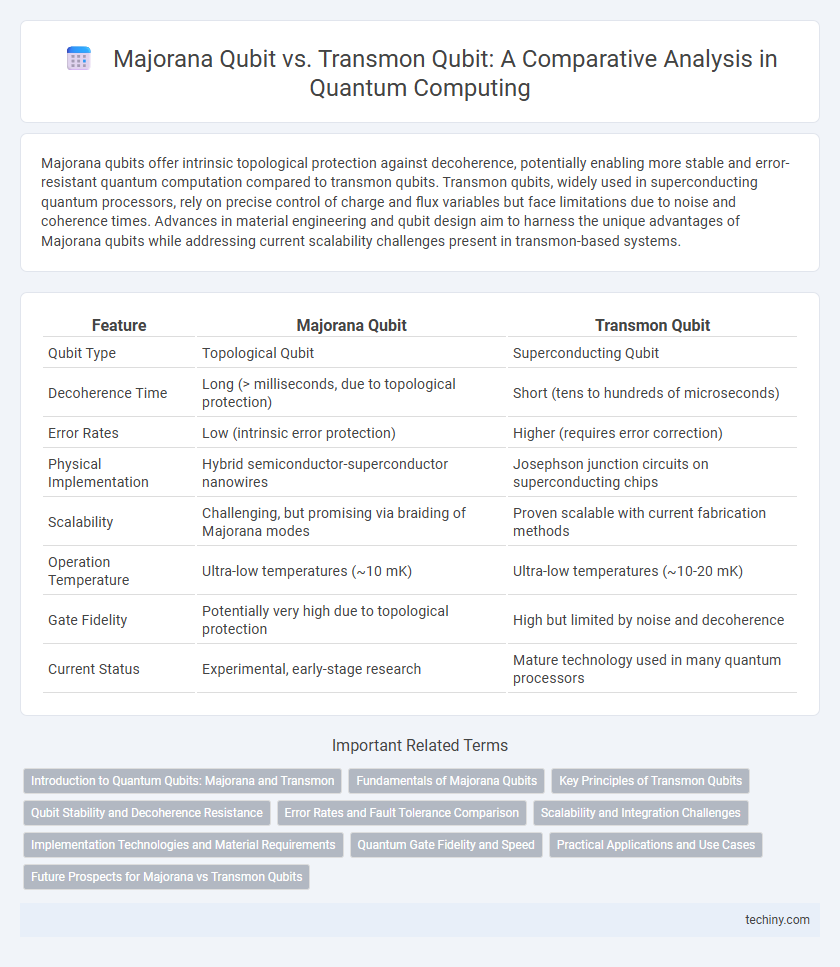Majorana qubits offer intrinsic topological protection against decoherence, potentially enabling more stable and error-resistant quantum computation compared to transmon qubits. Transmon qubits, widely used in superconducting quantum processors, rely on precise control of charge and flux variables but face limitations due to noise and coherence times. Advances in material engineering and qubit design aim to harness the unique advantages of Majorana qubits while addressing current scalability challenges present in transmon-based systems.
Table of Comparison
| Feature | Majorana Qubit | Transmon Qubit |
|---|---|---|
| Qubit Type | Topological Qubit | Superconducting Qubit |
| Decoherence Time | Long (> milliseconds, due to topological protection) | Short (tens to hundreds of microseconds) |
| Error Rates | Low (intrinsic error protection) | Higher (requires error correction) |
| Physical Implementation | Hybrid semiconductor-superconductor nanowires | Josephson junction circuits on superconducting chips |
| Scalability | Challenging, but promising via braiding of Majorana modes | Proven scalable with current fabrication methods |
| Operation Temperature | Ultra-low temperatures (~10 mK) | Ultra-low temperatures (~10-20 mK) |
| Gate Fidelity | Potentially very high due to topological protection | High but limited by noise and decoherence |
| Current Status | Experimental, early-stage research | Mature technology used in many quantum processors |
Introduction to Quantum Qubits: Majorana and Transmon
Majorana qubits leverage non-abelian anyons for topological protection, offering enhanced fault tolerance in quantum computing. Transmon qubits, based on superconducting circuits with Josephson junctions, provide high coherence times and scalability for current quantum processors. Understanding these qubit types is essential for advancing quantum architectures and error correction techniques.
Fundamentals of Majorana Qubits
Majorana qubits leverage the non-Abelian statistics of Majorana zero modes, enabling topological quantum computation that inherently protects against local decoherence and error. These qubits encode information in pairs of spatially separated Majorana bound states, resulting in fault-tolerant operations through braiding. In contrast, transmon qubits rely on superconducting circuits with charge-noise suppression but remain more susceptible to environmental noise due to lack of intrinsic topological protection.
Key Principles of Transmon Qubits
Transmon qubits are superconducting qubits designed to reduce charge noise sensitivity by increasing the ratio of Josephson energy to charging energy, enhancing coherence times. They operate based on the quantization of the superconducting phase difference across a Josephson junction, enabling discrete energy levels for quantum information processing. This architecture allows strong coupling to microwave resonators for efficient control and readout in quantum circuits.
Qubit Stability and Decoherence Resistance
Majorana qubits exhibit enhanced qubit stability due to their topological protection, which inherently resists local noise and decoherence processes, making them highly robust compared to conventional superconducting qubits. Transmon qubits, while widely used for their scalability and relatively long coherence times, remain susceptible to charge noise and decoherence from environmental interactions, limiting their performance in large-scale quantum computing. The intrinsic decoherence resistance of Majorana qubits positions them as promising candidates for fault-tolerant quantum computing architectures, surpassing the stability metrics typically associated with transmon qubits.
Error Rates and Fault Tolerance Comparison
Majorana qubits exhibit significantly lower error rates due to their topological protection, which makes them inherently resistant to local noise and decoherence, enhancing fault tolerance compared to conventional transmon qubits. Transmon qubits, while more mature and easier to fabricate, suffer from higher error rates primarily caused by charge noise and photon loss in superconducting circuits, limiting their fault-tolerant scalability. The intrinsic error suppression in Majorana qubits presents a promising pathway for building scalable quantum computers with more robust error correction protocols.
Scalability and Integration Challenges
Majorana qubits offer potential advantages in scalability due to their topological protection, which reduces error rates and fault tolerance requirements compared to transmon qubits. Transmon qubits, while currently more mature in integration with existing superconducting quantum processors, face challenges scaling beyond tens of qubits due to noise and cross-talk issues. The integration of Majorana qubits into scalable architectures remains experimentally challenging, requiring precise material engineering and control over exotic quasiparticles.
Implementation Technologies and Material Requirements
Majorana qubits leverage topological superconductors, utilizing materials like indium antimonide nanowires proximitized by aluminum to achieve fault-tolerant quantum computation through non-abelian anyons. Transmon qubits are implemented using superconducting circuits composed primarily of aluminum or niobium on silicon or sapphire substrates, relying on Josephson junctions to enhance coherence times by reducing charge noise sensitivity. The Majorana qubit's reliance on exotic materials and cryogenic conditions contrasts with transmon's more mature fabrication techniques, making their material and technological demands distinct within quantum hardware development.
Quantum Gate Fidelity and Speed
Majorana qubits demonstrate superior quantum gate fidelity due to their topological protection against local noise, achieving error rates significantly lower than conventional transmon qubits. While transmon qubits benefit from faster gate speeds with nanosecond-scale operations, they suffer from increased decoherence and higher error rates, limiting overall fidelity. Emerging research aims to combine Majorana topological robustness with transmon-like fast control to optimize both quantum gate fidelity and operational speed in scalable quantum processors.
Practical Applications and Use Cases
Majorana qubits offer potential advantages in fault-tolerant quantum computing due to their topological protection, making them promising for scalable quantum error correction in practical applications like cryptography and complex simulations. Transmon qubits, widely used in current quantum processors such as those by IBM and Google, excel in coherence time and gate fidelity, enabling near-term quantum algorithms and optimization tasks. While Majorana qubits remain in experimental stages, transmons dominate real-world use cases including quantum chemistry, material science, and machine learning.
Future Prospects for Majorana vs Transmon Qubits
Majorana qubits offer robust topological protection against local noise, promising enhanced coherence times and fault-tolerant quantum computation compared to conventional transmon qubits. Transmon qubits, currently leading in scalability and control precision, face challenges with decoherence and error correction overhead. Future advancements in Majorana qubit fabrication and manipulation techniques could enable more reliable quantum processors, potentially surpassing transmon-based architectures in large-scale quantum computing applications.
Majorana Qubit vs Transmon Qubit Infographic

 techiny.com
techiny.com